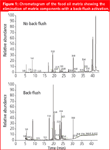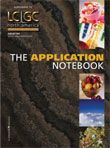Tandem GC–MS Analysis of Pesticides in Food Oils by Large Volume Injection with a Back-flush Option
The Application Notebook
As the global sourcing of foodstuffs becomes more common, the number of pesticide analyses performed continues to increase to test these sources for compliance with various regulations. The sheer number of analyses dictates that utilized methods must be reliable, robust and inexpensive.
Introduction
As the global sourcing of foodstuffs becomes more common, the number of pesticide analyses performed continues to increase to test these sources for compliance with various regulations. The sheer number of analyses dictates that utilized methods must be reliable, robust and inexpensive. When this pesticide analysis is performed using a GC–MS ion trap coupled with a back-flush option, pesticides can easily be detected at very low concentrations in challenging food matrices with benefits of enhanced robustness and minimal instrument maintenance.1

Figure 1: Chromatogram of the food oil matrix showing the elimination of matrix components with a back-flush activation.
Experimental
Method development was undertaken to create a robust and sensitive way to analyse pesticides in a complicated food matrix. In this application, a tandem GC–MS–MS analytical method was developed using the PolarisQ GC–MS quadrupole ion trap to provide a robust and sensitive analysis of over 45 pesticides in a food oil extract. This particular food extract, because of high concentrations of triglycerides, was especially challenging.
A two-stage back flush option was employed along with a large volume injection technique to reduce the amount of solvent injected on-column, as well as preventing late eluting components of the matrix from entering the analytical column. Minimal sample clean up and preparation was performed before analysis, and the use of tandem mass spectral analyses allowed for the elimination of matrix interference.
Results and Conclusion
The time savings of using a second back-flush to prevent the late eluting triglycerides from entering the analytical column was demonstrated in a reduction of run time from 45 to 35 minutes. In addition, required maintenance was less frequent because less matrix entered into the analytical column and mass spectrometer. During the course of these experiments, which was over 700 injections over a one month period, the ion volume of the MS was cleaned only once, the injector liner was replaced once, and the injector port septa was changed once every 50 injections. The guard column was never trimmed or replaced, which indicated that the back-flush system did a thorough job of purging matrix contamination from the system.
Matt Lasater and Jessie Butler, Thermo Electron Corporation, Austin, Texas, USA.
References
1. J. Butler, Comparison of GC/MS/MS to GC/MS Analysis of Pesticides in Vegetables, Thermo Electron Corporation Application Note AN10017.
New Study Reviews Chromatography Methods for Flavonoid Analysis
April 21st 2025Flavonoids are widely used metabolites that carry out various functions in different industries, such as food and cosmetics. Detecting, separating, and quantifying them in fruit species can be a complicated process.
Analytical Challenges in Measuring Migration from Food Contact Materials
November 2nd 2015Food contact materials contain low molecular weight additives and processing aids which can migrate into foods leading to trace levels of contamination. Food safety is ensured through regulations, comprising compositional controls and migration limits, which present a significant analytical challenge to the food industry to ensure compliance and demonstrate due diligence. Of the various analytical approaches, LC-MS/MS has proved to be an essential tool in monitoring migration of target compounds into foods, and more sophisticated approaches such as LC-high resolution MS (Orbitrap) are being increasingly used for untargeted analysis to monitor non-intentionally added substances. This podcast will provide an overview to this area, illustrated with various applications showing current approaches being employed.

.png&w=3840&q=75)

.png&w=3840&q=75)



.png&w=3840&q=75)



.png&w=3840&q=75)



